The Impact of Social Media Marketing: A Detailed Literature Review
VerifiedAdded on 2022/12/27
|8
|3040
|62
Literature Review
AI Summary
This literature review investigates the effects of social media on marketing, focusing on platforms such as Facebook and Instagram. The review is structured around three main themes: definition, positive effects, and negative effects. It explores how social media marketing enhances brand awareness, customer engagement, and sales, while also examining the potential for fraud and data security concerns. The analysis incorporates various scholarly sources to evaluate the advantages and disadvantages of social media marketing, concluding with a comprehensive overview of its impact on modern business strategies. The review highlights the importance of adapting marketing approaches to the evolving digital landscape, emphasizing the need for businesses to navigate both the opportunities and challenges presented by social media platforms. The review also discusses the need for companies to use integrated marketing approaches, taking into account the limitations of social media marketing.

Literature Review
Paraphrase This Document
Need a fresh take? Get an instant paraphrase of this document with our AI Paraphraser
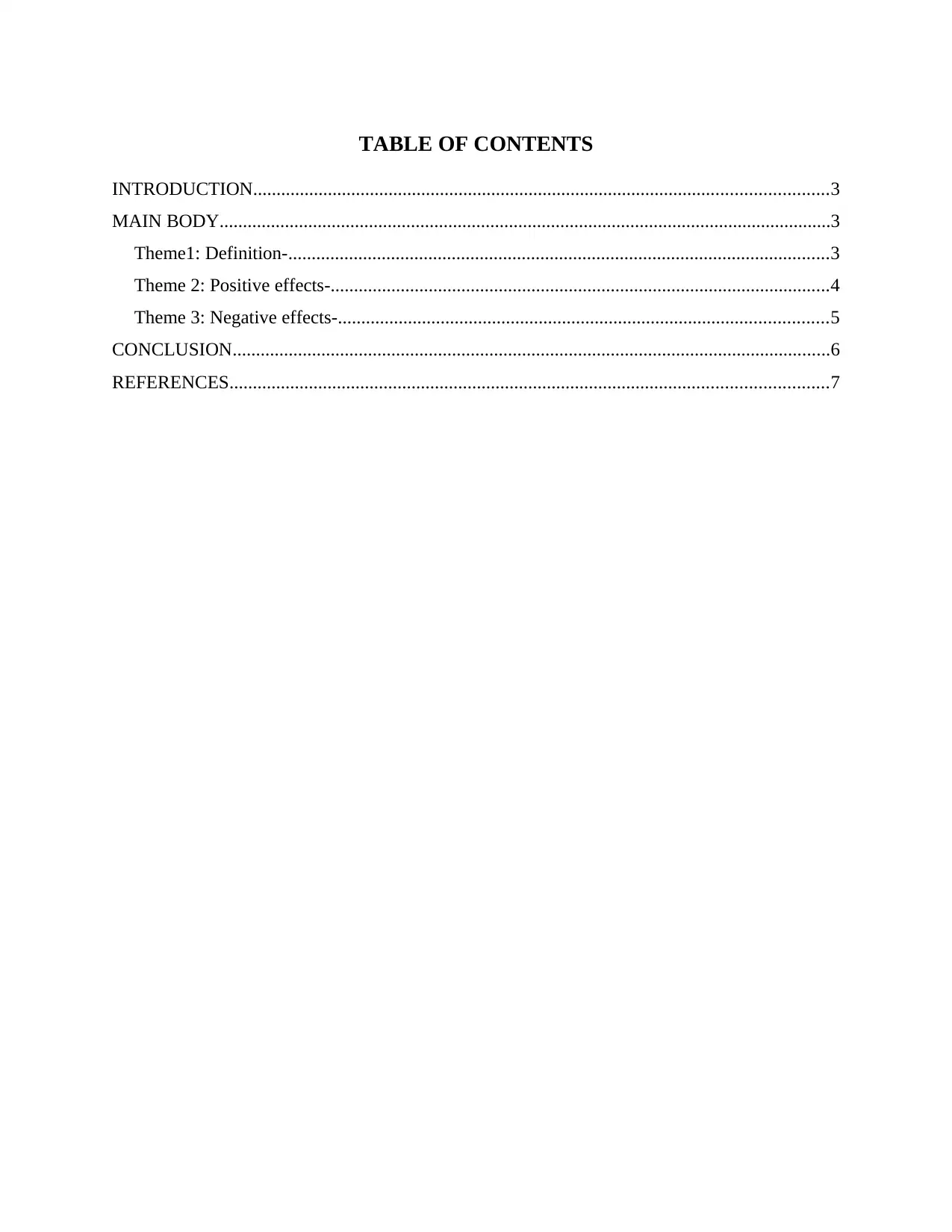
TABLE OF CONTENTS
INTRODUCTION...........................................................................................................................3
MAIN BODY...................................................................................................................................3
Theme1: Definition-....................................................................................................................3
Theme 2: Positive effects-...........................................................................................................4
Theme 3: Negative effects-.........................................................................................................5
CONCLUSION................................................................................................................................6
REFERENCES................................................................................................................................7
INTRODUCTION...........................................................................................................................3
MAIN BODY...................................................................................................................................3
Theme1: Definition-....................................................................................................................3
Theme 2: Positive effects-...........................................................................................................4
Theme 3: Negative effects-.........................................................................................................5
CONCLUSION................................................................................................................................6
REFERENCES................................................................................................................................7
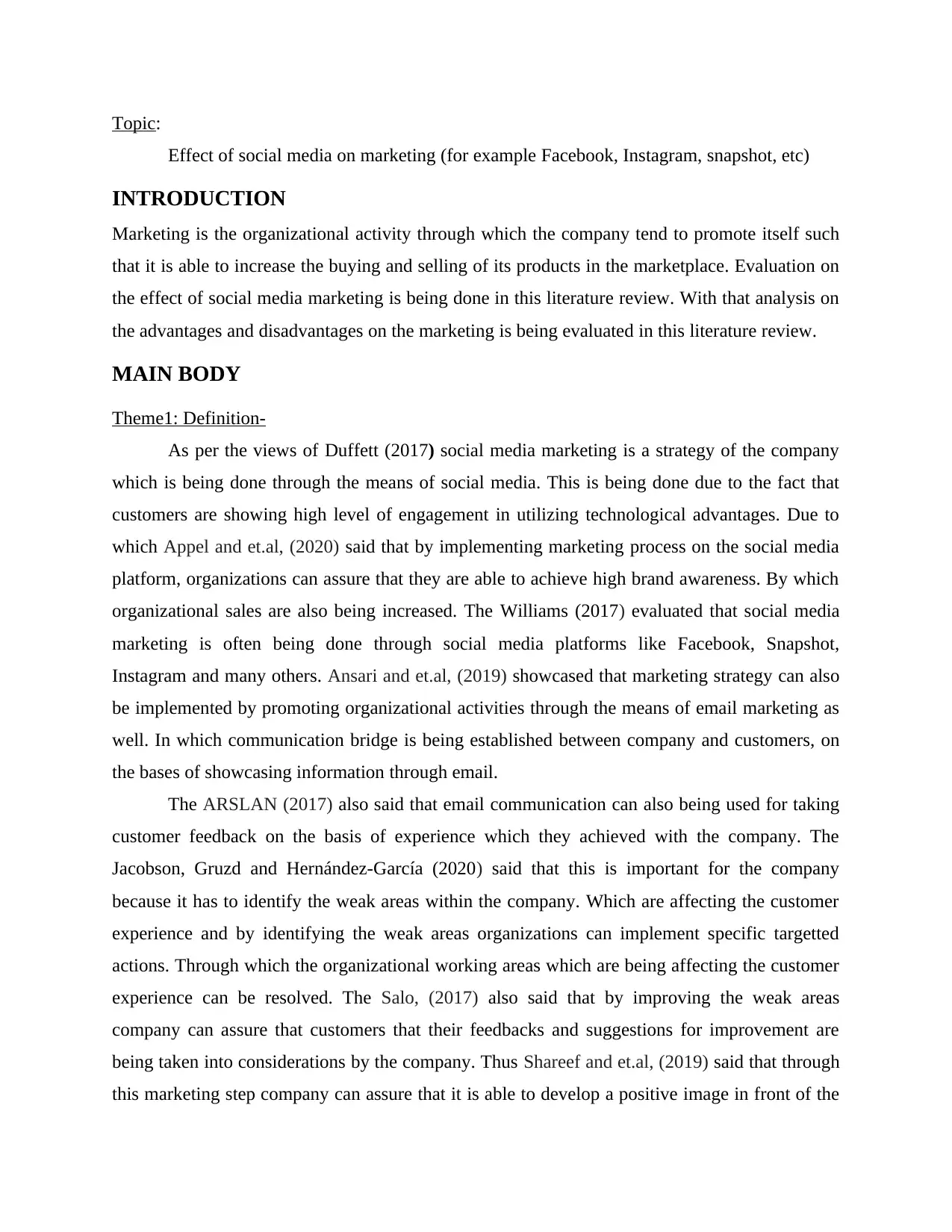
Topic:
Effect of social media on marketing (for example Facebook, Instagram, snapshot, etc)
INTRODUCTION
Marketing is the organizational activity through which the company tend to promote itself such
that it is able to increase the buying and selling of its products in the marketplace. Evaluation on
the effect of social media marketing is being done in this literature review. With that analysis on
the advantages and disadvantages on the marketing is being evaluated in this literature review.
MAIN BODY
Theme1: Definition-
As per the views of Duffett (2017) social media marketing is a strategy of the company
which is being done through the means of social media. This is being done due to the fact that
customers are showing high level of engagement in utilizing technological advantages. Due to
which Appel and et.al, (2020) said that by implementing marketing process on the social media
platform, organizations can assure that they are able to achieve high brand awareness. By which
organizational sales are also being increased. The Williams (2017) evaluated that social media
marketing is often being done through social media platforms like Facebook, Snapshot,
Instagram and many others. Ansari and et.al, (2019) showcased that marketing strategy can also
be implemented by promoting organizational activities through the means of email marketing as
well. In which communication bridge is being established between company and customers, on
the bases of showcasing information through email.
The ARSLAN (2017) also said that email communication can also being used for taking
customer feedback on the basis of experience which they achieved with the company. The
Jacobson, Gruzd and Hernández-García (2020) said that this is important for the company
because it has to identify the weak areas within the company. Which are affecting the customer
experience and by identifying the weak areas organizations can implement specific targetted
actions. Through which the organizational working areas which are being affecting the customer
experience can be resolved. The Salo, (2017) also said that by improving the weak areas
company can assure that customers that their feedbacks and suggestions for improvement are
being taken into considerations by the company. Thus Shareef and et.al, (2019) said that through
this marketing step company can assure that it is able to develop a positive image in front of the
Effect of social media on marketing (for example Facebook, Instagram, snapshot, etc)
INTRODUCTION
Marketing is the organizational activity through which the company tend to promote itself such
that it is able to increase the buying and selling of its products in the marketplace. Evaluation on
the effect of social media marketing is being done in this literature review. With that analysis on
the advantages and disadvantages on the marketing is being evaluated in this literature review.
MAIN BODY
Theme1: Definition-
As per the views of Duffett (2017) social media marketing is a strategy of the company
which is being done through the means of social media. This is being done due to the fact that
customers are showing high level of engagement in utilizing technological advantages. Due to
which Appel and et.al, (2020) said that by implementing marketing process on the social media
platform, organizations can assure that they are able to achieve high brand awareness. By which
organizational sales are also being increased. The Williams (2017) evaluated that social media
marketing is often being done through social media platforms like Facebook, Snapshot,
Instagram and many others. Ansari and et.al, (2019) showcased that marketing strategy can also
be implemented by promoting organizational activities through the means of email marketing as
well. In which communication bridge is being established between company and customers, on
the bases of showcasing information through email.
The ARSLAN (2017) also said that email communication can also being used for taking
customer feedback on the basis of experience which they achieved with the company. The
Jacobson, Gruzd and Hernández-García (2020) said that this is important for the company
because it has to identify the weak areas within the company. Which are affecting the customer
experience and by identifying the weak areas organizations can implement specific targetted
actions. Through which the organizational working areas which are being affecting the customer
experience can be resolved. The Salo, (2017) also said that by improving the weak areas
company can assure that customers that their feedbacks and suggestions for improvement are
being taken into considerations by the company. Thus Shareef and et.al, (2019) said that through
this marketing step company can assure that it is able to develop a positive image in front of the
⊘ This is a preview!⊘
Do you want full access?
Subscribe today to unlock all pages.

Trusted by 1+ million students worldwide
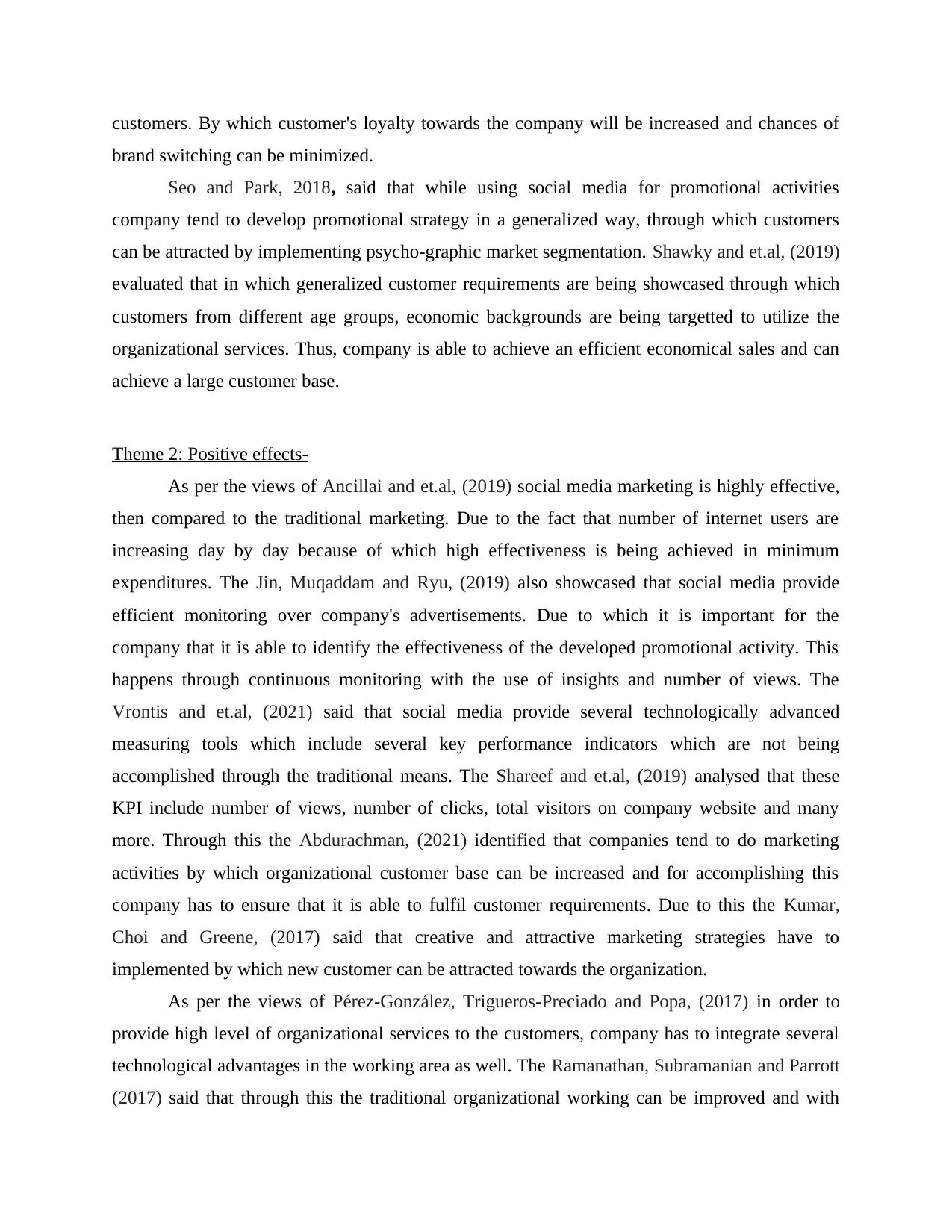
customers. By which customer's loyalty towards the company will be increased and chances of
brand switching can be minimized.
Seo and Park, 2018, said that while using social media for promotional activities
company tend to develop promotional strategy in a generalized way, through which customers
can be attracted by implementing psycho-graphic market segmentation. Shawky and et.al, (2019)
evaluated that in which generalized customer requirements are being showcased through which
customers from different age groups, economic backgrounds are being targetted to utilize the
organizational services. Thus, company is able to achieve an efficient economical sales and can
achieve a large customer base.
Theme 2: Positive effects-
As per the views of Ancillai and et.al, (2019) social media marketing is highly effective,
then compared to the traditional marketing. Due to the fact that number of internet users are
increasing day by day because of which high effectiveness is being achieved in minimum
expenditures. The Jin, Muqaddam and Ryu, (2019) also showcased that social media provide
efficient monitoring over company's advertisements. Due to which it is important for the
company that it is able to identify the effectiveness of the developed promotional activity. This
happens through continuous monitoring with the use of insights and number of views. The
Vrontis and et.al, (2021) said that social media provide several technologically advanced
measuring tools which include several key performance indicators which are not being
accomplished through the traditional means. The Shareef and et.al, (2019) analysed that these
KPI include number of views, number of clicks, total visitors on company website and many
more. Through this the Abdurachman, (2021) identified that companies tend to do marketing
activities by which organizational customer base can be increased and for accomplishing this
company has to ensure that it is able to fulfil customer requirements. Due to this the Kumar,
Choi and Greene, (2017) said that creative and attractive marketing strategies have to
implemented by which new customer can be attracted towards the organization.
As per the views of Pérez-González, Trigueros-Preciado and Popa, (2017) in order to
provide high level of organizational services to the customers, company has to integrate several
technological advantages in the working area as well. The Ramanathan, Subramanian and Parrott
(2017) said that through this the traditional organizational working can be improved and with
brand switching can be minimized.
Seo and Park, 2018, said that while using social media for promotional activities
company tend to develop promotional strategy in a generalized way, through which customers
can be attracted by implementing psycho-graphic market segmentation. Shawky and et.al, (2019)
evaluated that in which generalized customer requirements are being showcased through which
customers from different age groups, economic backgrounds are being targetted to utilize the
organizational services. Thus, company is able to achieve an efficient economical sales and can
achieve a large customer base.
Theme 2: Positive effects-
As per the views of Ancillai and et.al, (2019) social media marketing is highly effective,
then compared to the traditional marketing. Due to the fact that number of internet users are
increasing day by day because of which high effectiveness is being achieved in minimum
expenditures. The Jin, Muqaddam and Ryu, (2019) also showcased that social media provide
efficient monitoring over company's advertisements. Due to which it is important for the
company that it is able to identify the effectiveness of the developed promotional activity. This
happens through continuous monitoring with the use of insights and number of views. The
Vrontis and et.al, (2021) said that social media provide several technologically advanced
measuring tools which include several key performance indicators which are not being
accomplished through the traditional means. The Shareef and et.al, (2019) analysed that these
KPI include number of views, number of clicks, total visitors on company website and many
more. Through this the Abdurachman, (2021) identified that companies tend to do marketing
activities by which organizational customer base can be increased and for accomplishing this
company has to ensure that it is able to fulfil customer requirements. Due to this the Kumar,
Choi and Greene, (2017) said that creative and attractive marketing strategies have to
implemented by which new customer can be attracted towards the organization.
As per the views of Pérez-González, Trigueros-Preciado and Popa, (2017) in order to
provide high level of organizational services to the customers, company has to integrate several
technological advantages in the working area as well. The Ramanathan, Subramanian and Parrott
(2017) said that through this the traditional organizational working can be improved and with
Paraphrase This Document
Need a fresh take? Get an instant paraphrase of this document with our AI Paraphraser
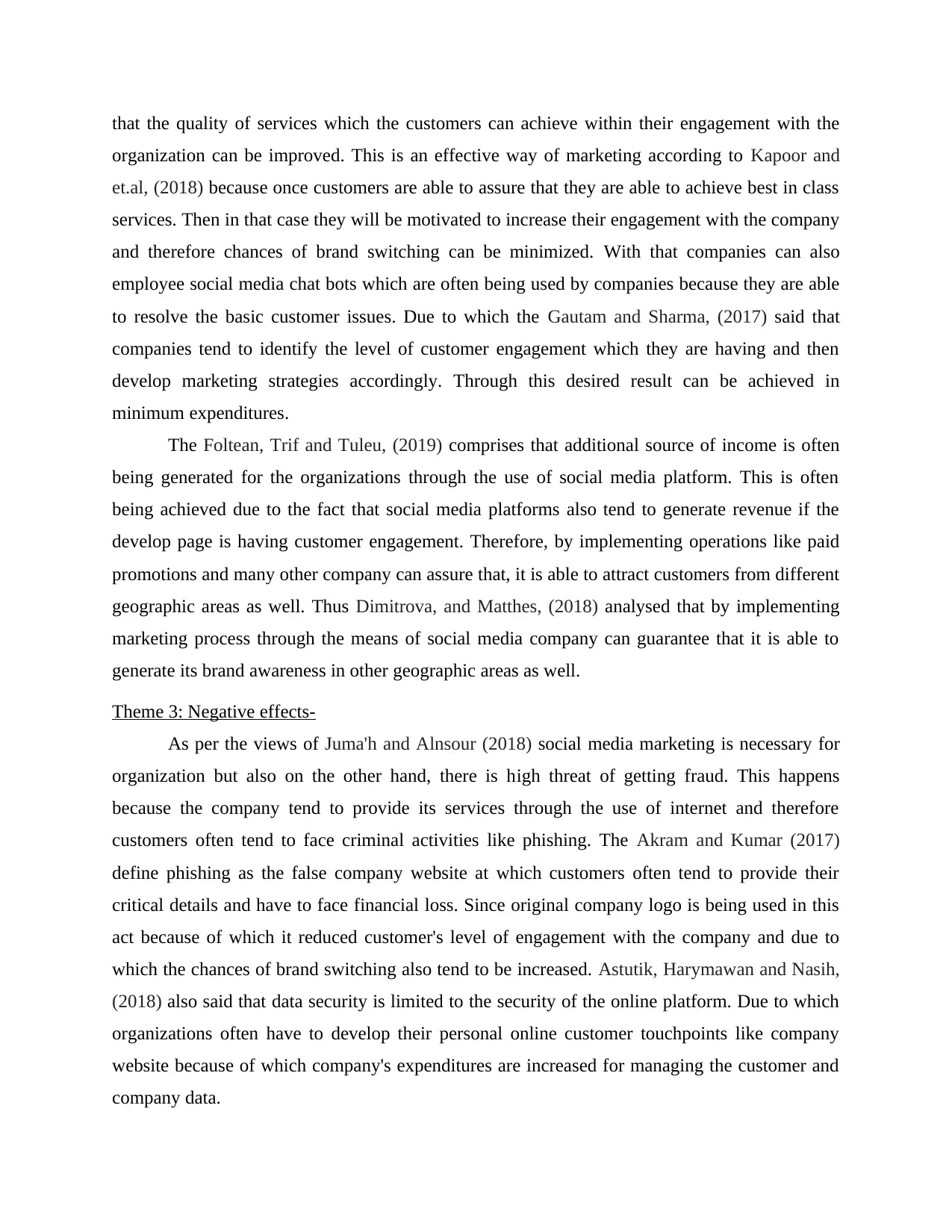
that the quality of services which the customers can achieve within their engagement with the
organization can be improved. This is an effective way of marketing according to Kapoor and
et.al, (2018) because once customers are able to assure that they are able to achieve best in class
services. Then in that case they will be motivated to increase their engagement with the company
and therefore chances of brand switching can be minimized. With that companies can also
employee social media chat bots which are often being used by companies because they are able
to resolve the basic customer issues. Due to which the Gautam and Sharma, (2017) said that
companies tend to identify the level of customer engagement which they are having and then
develop marketing strategies accordingly. Through this desired result can be achieved in
minimum expenditures.
The Foltean, Trif and Tuleu, (2019) comprises that additional source of income is often
being generated for the organizations through the use of social media platform. This is often
being achieved due to the fact that social media platforms also tend to generate revenue if the
develop page is having customer engagement. Therefore, by implementing operations like paid
promotions and many other company can assure that, it is able to attract customers from different
geographic areas as well. Thus Dimitrova, and Matthes, (2018) analysed that by implementing
marketing process through the means of social media company can guarantee that it is able to
generate its brand awareness in other geographic areas as well.
Theme 3: Negative effects-
As per the views of Juma'h and Alnsour (2018) social media marketing is necessary for
organization but also on the other hand, there is high threat of getting fraud. This happens
because the company tend to provide its services through the use of internet and therefore
customers often tend to face criminal activities like phishing. The Akram and Kumar (2017)
define phishing as the false company website at which customers often tend to provide their
critical details and have to face financial loss. Since original company logo is being used in this
act because of which it reduced customer's level of engagement with the company and due to
which the chances of brand switching also tend to be increased. Astutik, Harymawan and Nasih,
(2018) also said that data security is limited to the security of the online platform. Due to which
organizations often have to develop their personal online customer touchpoints like company
website because of which company's expenditures are increased for managing the customer and
company data.
organization can be improved. This is an effective way of marketing according to Kapoor and
et.al, (2018) because once customers are able to assure that they are able to achieve best in class
services. Then in that case they will be motivated to increase their engagement with the company
and therefore chances of brand switching can be minimized. With that companies can also
employee social media chat bots which are often being used by companies because they are able
to resolve the basic customer issues. Due to which the Gautam and Sharma, (2017) said that
companies tend to identify the level of customer engagement which they are having and then
develop marketing strategies accordingly. Through this desired result can be achieved in
minimum expenditures.
The Foltean, Trif and Tuleu, (2019) comprises that additional source of income is often
being generated for the organizations through the use of social media platform. This is often
being achieved due to the fact that social media platforms also tend to generate revenue if the
develop page is having customer engagement. Therefore, by implementing operations like paid
promotions and many other company can assure that, it is able to attract customers from different
geographic areas as well. Thus Dimitrova, and Matthes, (2018) analysed that by implementing
marketing process through the means of social media company can guarantee that it is able to
generate its brand awareness in other geographic areas as well.
Theme 3: Negative effects-
As per the views of Juma'h and Alnsour (2018) social media marketing is necessary for
organization but also on the other hand, there is high threat of getting fraud. This happens
because the company tend to provide its services through the use of internet and therefore
customers often tend to face criminal activities like phishing. The Akram and Kumar (2017)
define phishing as the false company website at which customers often tend to provide their
critical details and have to face financial loss. Since original company logo is being used in this
act because of which it reduced customer's level of engagement with the company and due to
which the chances of brand switching also tend to be increased. Astutik, Harymawan and Nasih,
(2018) also said that data security is limited to the security of the online platform. Due to which
organizations often have to develop their personal online customer touchpoints like company
website because of which company's expenditures are increased for managing the customer and
company data.
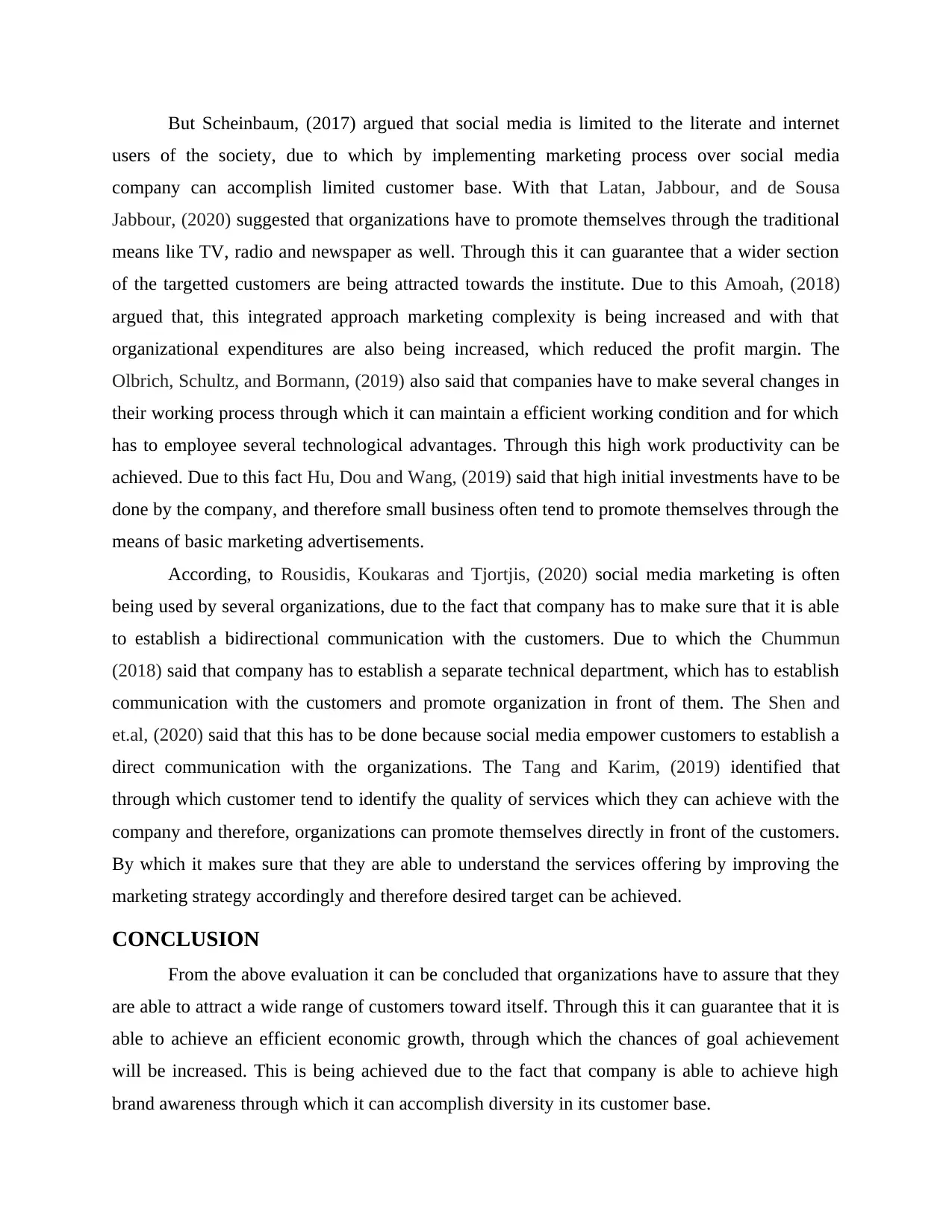
But Scheinbaum, (2017) argued that social media is limited to the literate and internet
users of the society, due to which by implementing marketing process over social media
company can accomplish limited customer base. With that Latan, Jabbour, and de Sousa
Jabbour, (2020) suggested that organizations have to promote themselves through the traditional
means like TV, radio and newspaper as well. Through this it can guarantee that a wider section
of the targetted customers are being attracted towards the institute. Due to this Amoah, (2018)
argued that, this integrated approach marketing complexity is being increased and with that
organizational expenditures are also being increased, which reduced the profit margin. The
Olbrich, Schultz, and Bormann, (2019) also said that companies have to make several changes in
their working process through which it can maintain a efficient working condition and for which
has to employee several technological advantages. Through this high work productivity can be
achieved. Due to this fact Hu, Dou and Wang, (2019) said that high initial investments have to be
done by the company, and therefore small business often tend to promote themselves through the
means of basic marketing advertisements.
According, to Rousidis, Koukaras and Tjortjis, (2020) social media marketing is often
being used by several organizations, due to the fact that company has to make sure that it is able
to establish a bidirectional communication with the customers. Due to which the Chummun
(2018) said that company has to establish a separate technical department, which has to establish
communication with the customers and promote organization in front of them. The Shen and
et.al, (2020) said that this has to be done because social media empower customers to establish a
direct communication with the organizations. The Tang and Karim, (2019) identified that
through which customer tend to identify the quality of services which they can achieve with the
company and therefore, organizations can promote themselves directly in front of the customers.
By which it makes sure that they are able to understand the services offering by improving the
marketing strategy accordingly and therefore desired target can be achieved.
CONCLUSION
From the above evaluation it can be concluded that organizations have to assure that they
are able to attract a wide range of customers toward itself. Through this it can guarantee that it is
able to achieve an efficient economic growth, through which the chances of goal achievement
will be increased. This is being achieved due to the fact that company is able to achieve high
brand awareness through which it can accomplish diversity in its customer base.
users of the society, due to which by implementing marketing process over social media
company can accomplish limited customer base. With that Latan, Jabbour, and de Sousa
Jabbour, (2020) suggested that organizations have to promote themselves through the traditional
means like TV, radio and newspaper as well. Through this it can guarantee that a wider section
of the targetted customers are being attracted towards the institute. Due to this Amoah, (2018)
argued that, this integrated approach marketing complexity is being increased and with that
organizational expenditures are also being increased, which reduced the profit margin. The
Olbrich, Schultz, and Bormann, (2019) also said that companies have to make several changes in
their working process through which it can maintain a efficient working condition and for which
has to employee several technological advantages. Through this high work productivity can be
achieved. Due to this fact Hu, Dou and Wang, (2019) said that high initial investments have to be
done by the company, and therefore small business often tend to promote themselves through the
means of basic marketing advertisements.
According, to Rousidis, Koukaras and Tjortjis, (2020) social media marketing is often
being used by several organizations, due to the fact that company has to make sure that it is able
to establish a bidirectional communication with the customers. Due to which the Chummun
(2018) said that company has to establish a separate technical department, which has to establish
communication with the customers and promote organization in front of them. The Shen and
et.al, (2020) said that this has to be done because social media empower customers to establish a
direct communication with the organizations. The Tang and Karim, (2019) identified that
through which customer tend to identify the quality of services which they can achieve with the
company and therefore, organizations can promote themselves directly in front of the customers.
By which it makes sure that they are able to understand the services offering by improving the
marketing strategy accordingly and therefore desired target can be achieved.
CONCLUSION
From the above evaluation it can be concluded that organizations have to assure that they
are able to attract a wide range of customers toward itself. Through this it can guarantee that it is
able to achieve an efficient economic growth, through which the chances of goal achievement
will be increased. This is being achieved due to the fact that company is able to achieve high
brand awareness through which it can accomplish diversity in its customer base.
⊘ This is a preview!⊘
Do you want full access?
Subscribe today to unlock all pages.

Trusted by 1+ million students worldwide

REFERENCES
Books and Journals
Abdurachman, E., 2021, March. The Effects of Social Media, Email Marketing, Website, Mobile
Applications Towards Purchase Intention-Consumer Decisions. In 2nd Southeast Asian
Academic Forum on Sustainable Development (SEA-AFSID 2018) (pp. 10-12). Atlantis
Press.
Akram, W. and Kumar, R., 2017. A study on positive and negative effects of social media on
society. International Journal of Computer Sciences and Engineering. 5(10). pp.347-
354.
Amoah, B., 2018. Mr Ponzi with fraud scheme is knocking: Investors who may open. Global
Business Review. 19(5). pp.1115-1128.
Ancillai, C. and et.al, 2019. Advancing social media driven sales research: Establishing
conceptual foundations for B-to-B social selling. Industrial Marketing Management. 82.
pp.293-308.
Ansari, S. and et.al, 2019. Impact of brand awareness and social media content marketing on
consumer purchase decision. Journal of Public Value and Administration Insights. 2(2).
pp.5-10.
Appel, G. and et.al, 2020. The future of social media in marketing. Journal of the Academy of
Marketing Science. 48(1). pp.79-95.
ARSLAN, E., 2017. The effect of social media on marketing. Uluslararası Avrasya Sosyal
Bilimler Dergisi. 8(28). pp.131-143.
Astutik, D., Harymawan, I. and Nasih, M., 2018. The effectiveness of social media and press
release transparency to detect indications of financial fraud. Editorial Board. 1507.
Chummun, B.Z., 2018. How can Artificial Intelligence reduce fraud in the inclusive cover niche:
a case of developing African countries. Journal of Contemporary
Management. 15(Special Edition 1). pp.1-17.
Dimitrova, D.V. and Matthes, J., 2018. Social media in political campaigning around the world:
Theoretical and methodological challenges.
Duffett, R.G., 2017. Influence of social media marketing communications on young consumers’
attitudes. Young Consumers.
Foltean, F.S., Trif, S.M. and Tuleu, D.L., 2019. Customer relationship management capabilities
and social media technology use: Consequences on firm performance. Journal of
Business Research. 104. pp.563-575.
Gautam, V. and Sharma, V., 2017. The mediating role of customer relationship on the social
media marketing and purchase intention relationship with special reference to luxury
fashion brands. Journal of Promotion Management. 23(6). pp.872-888.
Hu, H., Dou, B. and Wang, A., 2019. Corporate Social Responsibility Information Disclosure
and Corporate Fraud—“Risk Reduction” Effect or “Window Dressing”
Effect?. Sustainability. 11(4). p.1141.
Jacobson, J., Gruzd, A. and Hernández-García, Á., 2020. Social media marketing: Who is
watching the watchers?. Journal of Retailing and Consumer Services, 53.
Jin, S.V., Muqaddam, A. and Ryu, E., 2019. Instafamous and social media influencer
marketing. Marketing Intelligence & Planning.
Books and Journals
Abdurachman, E., 2021, March. The Effects of Social Media, Email Marketing, Website, Mobile
Applications Towards Purchase Intention-Consumer Decisions. In 2nd Southeast Asian
Academic Forum on Sustainable Development (SEA-AFSID 2018) (pp. 10-12). Atlantis
Press.
Akram, W. and Kumar, R., 2017. A study on positive and negative effects of social media on
society. International Journal of Computer Sciences and Engineering. 5(10). pp.347-
354.
Amoah, B., 2018. Mr Ponzi with fraud scheme is knocking: Investors who may open. Global
Business Review. 19(5). pp.1115-1128.
Ancillai, C. and et.al, 2019. Advancing social media driven sales research: Establishing
conceptual foundations for B-to-B social selling. Industrial Marketing Management. 82.
pp.293-308.
Ansari, S. and et.al, 2019. Impact of brand awareness and social media content marketing on
consumer purchase decision. Journal of Public Value and Administration Insights. 2(2).
pp.5-10.
Appel, G. and et.al, 2020. The future of social media in marketing. Journal of the Academy of
Marketing Science. 48(1). pp.79-95.
ARSLAN, E., 2017. The effect of social media on marketing. Uluslararası Avrasya Sosyal
Bilimler Dergisi. 8(28). pp.131-143.
Astutik, D., Harymawan, I. and Nasih, M., 2018. The effectiveness of social media and press
release transparency to detect indications of financial fraud. Editorial Board. 1507.
Chummun, B.Z., 2018. How can Artificial Intelligence reduce fraud in the inclusive cover niche:
a case of developing African countries. Journal of Contemporary
Management. 15(Special Edition 1). pp.1-17.
Dimitrova, D.V. and Matthes, J., 2018. Social media in political campaigning around the world:
Theoretical and methodological challenges.
Duffett, R.G., 2017. Influence of social media marketing communications on young consumers’
attitudes. Young Consumers.
Foltean, F.S., Trif, S.M. and Tuleu, D.L., 2019. Customer relationship management capabilities
and social media technology use: Consequences on firm performance. Journal of
Business Research. 104. pp.563-575.
Gautam, V. and Sharma, V., 2017. The mediating role of customer relationship on the social
media marketing and purchase intention relationship with special reference to luxury
fashion brands. Journal of Promotion Management. 23(6). pp.872-888.
Hu, H., Dou, B. and Wang, A., 2019. Corporate Social Responsibility Information Disclosure
and Corporate Fraud—“Risk Reduction” Effect or “Window Dressing”
Effect?. Sustainability. 11(4). p.1141.
Jacobson, J., Gruzd, A. and Hernández-García, Á., 2020. Social media marketing: Who is
watching the watchers?. Journal of Retailing and Consumer Services, 53.
Jin, S.V., Muqaddam, A. and Ryu, E., 2019. Instafamous and social media influencer
marketing. Marketing Intelligence & Planning.
Paraphrase This Document
Need a fresh take? Get an instant paraphrase of this document with our AI Paraphraser
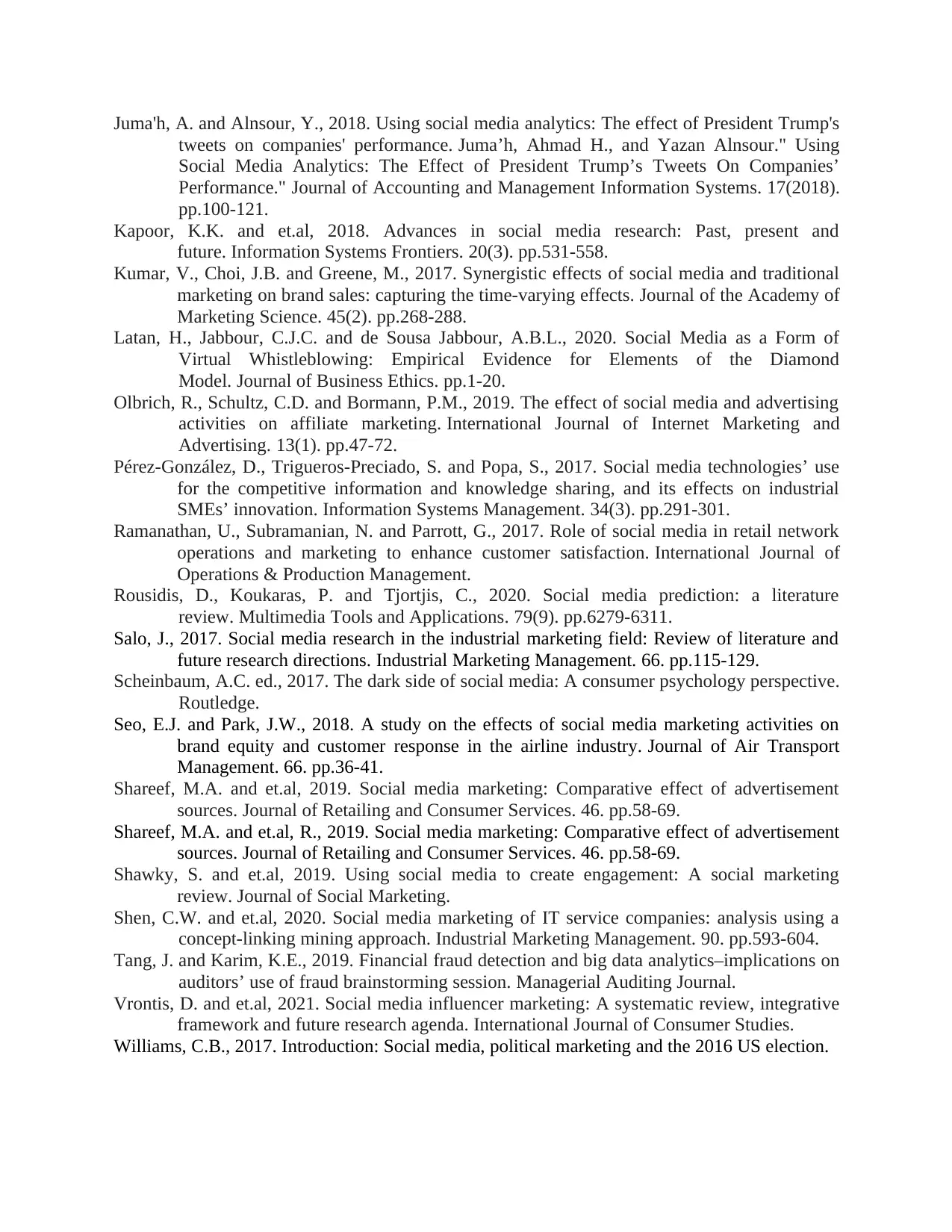
Juma'h, A. and Alnsour, Y., 2018. Using social media analytics: The effect of President Trump's
tweets on companies' performance. Juma’h, Ahmad H., and Yazan Alnsour." Using
Social Media Analytics: The Effect of President Trump’s Tweets On Companies’
Performance." Journal of Accounting and Management Information Systems. 17(2018).
pp.100-121.
Kapoor, K.K. and et.al, 2018. Advances in social media research: Past, present and
future. Information Systems Frontiers. 20(3). pp.531-558.
Kumar, V., Choi, J.B. and Greene, M., 2017. Synergistic effects of social media and traditional
marketing on brand sales: capturing the time-varying effects. Journal of the Academy of
Marketing Science. 45(2). pp.268-288.
Latan, H., Jabbour, C.J.C. and de Sousa Jabbour, A.B.L., 2020. Social Media as a Form of
Virtual Whistleblowing: Empirical Evidence for Elements of the Diamond
Model. Journal of Business Ethics. pp.1-20.
Olbrich, R., Schultz, C.D. and Bormann, P.M., 2019. The effect of social media and advertising
activities on affiliate marketing. International Journal of Internet Marketing and
Advertising. 13(1). pp.47-72.
Pérez-González, D., Trigueros-Preciado, S. and Popa, S., 2017. Social media technologies’ use
for the competitive information and knowledge sharing, and its effects on industrial
SMEs’ innovation. Information Systems Management. 34(3). pp.291-301.
Ramanathan, U., Subramanian, N. and Parrott, G., 2017. Role of social media in retail network
operations and marketing to enhance customer satisfaction. International Journal of
Operations & Production Management.
Rousidis, D., Koukaras, P. and Tjortjis, C., 2020. Social media prediction: a literature
review. Multimedia Tools and Applications. 79(9). pp.6279-6311.
Salo, J., 2017. Social media research in the industrial marketing field: Review of literature and
future research directions. Industrial Marketing Management. 66. pp.115-129.
Scheinbaum, A.C. ed., 2017. The dark side of social media: A consumer psychology perspective.
Routledge.
Seo, E.J. and Park, J.W., 2018. A study on the effects of social media marketing activities on
brand equity and customer response in the airline industry. Journal of Air Transport
Management. 66. pp.36-41.
Shareef, M.A. and et.al, 2019. Social media marketing: Comparative effect of advertisement
sources. Journal of Retailing and Consumer Services. 46. pp.58-69.
Shareef, M.A. and et.al, R., 2019. Social media marketing: Comparative effect of advertisement
sources. Journal of Retailing and Consumer Services. 46. pp.58-69.
Shawky, S. and et.al, 2019. Using social media to create engagement: A social marketing
review. Journal of Social Marketing.
Shen, C.W. and et.al, 2020. Social media marketing of IT service companies: analysis using a
concept-linking mining approach. Industrial Marketing Management. 90. pp.593-604.
Tang, J. and Karim, K.E., 2019. Financial fraud detection and big data analytics–implications on
auditors’ use of fraud brainstorming session. Managerial Auditing Journal.
Vrontis, D. and et.al, 2021. Social media influencer marketing: A systematic review, integrative
framework and future research agenda. International Journal of Consumer Studies.
Williams, C.B., 2017. Introduction: Social media, political marketing and the 2016 US election.
tweets on companies' performance. Juma’h, Ahmad H., and Yazan Alnsour." Using
Social Media Analytics: The Effect of President Trump’s Tweets On Companies’
Performance." Journal of Accounting and Management Information Systems. 17(2018).
pp.100-121.
Kapoor, K.K. and et.al, 2018. Advances in social media research: Past, present and
future. Information Systems Frontiers. 20(3). pp.531-558.
Kumar, V., Choi, J.B. and Greene, M., 2017. Synergistic effects of social media and traditional
marketing on brand sales: capturing the time-varying effects. Journal of the Academy of
Marketing Science. 45(2). pp.268-288.
Latan, H., Jabbour, C.J.C. and de Sousa Jabbour, A.B.L., 2020. Social Media as a Form of
Virtual Whistleblowing: Empirical Evidence for Elements of the Diamond
Model. Journal of Business Ethics. pp.1-20.
Olbrich, R., Schultz, C.D. and Bormann, P.M., 2019. The effect of social media and advertising
activities on affiliate marketing. International Journal of Internet Marketing and
Advertising. 13(1). pp.47-72.
Pérez-González, D., Trigueros-Preciado, S. and Popa, S., 2017. Social media technologies’ use
for the competitive information and knowledge sharing, and its effects on industrial
SMEs’ innovation. Information Systems Management. 34(3). pp.291-301.
Ramanathan, U., Subramanian, N. and Parrott, G., 2017. Role of social media in retail network
operations and marketing to enhance customer satisfaction. International Journal of
Operations & Production Management.
Rousidis, D., Koukaras, P. and Tjortjis, C., 2020. Social media prediction: a literature
review. Multimedia Tools and Applications. 79(9). pp.6279-6311.
Salo, J., 2017. Social media research in the industrial marketing field: Review of literature and
future research directions. Industrial Marketing Management. 66. pp.115-129.
Scheinbaum, A.C. ed., 2017. The dark side of social media: A consumer psychology perspective.
Routledge.
Seo, E.J. and Park, J.W., 2018. A study on the effects of social media marketing activities on
brand equity and customer response in the airline industry. Journal of Air Transport
Management. 66. pp.36-41.
Shareef, M.A. and et.al, 2019. Social media marketing: Comparative effect of advertisement
sources. Journal of Retailing and Consumer Services. 46. pp.58-69.
Shareef, M.A. and et.al, R., 2019. Social media marketing: Comparative effect of advertisement
sources. Journal of Retailing and Consumer Services. 46. pp.58-69.
Shawky, S. and et.al, 2019. Using social media to create engagement: A social marketing
review. Journal of Social Marketing.
Shen, C.W. and et.al, 2020. Social media marketing of IT service companies: analysis using a
concept-linking mining approach. Industrial Marketing Management. 90. pp.593-604.
Tang, J. and Karim, K.E., 2019. Financial fraud detection and big data analytics–implications on
auditors’ use of fraud brainstorming session. Managerial Auditing Journal.
Vrontis, D. and et.al, 2021. Social media influencer marketing: A systematic review, integrative
framework and future research agenda. International Journal of Consumer Studies.
Williams, C.B., 2017. Introduction: Social media, political marketing and the 2016 US election.
1 out of 8
Related Documents
Your All-in-One AI-Powered Toolkit for Academic Success.
+13062052269
info@desklib.com
Available 24*7 on WhatsApp / Email
![[object Object]](/_next/static/media/star-bottom.7253800d.svg)
Unlock your academic potential
Copyright © 2020–2025 A2Z Services. All Rights Reserved. Developed and managed by ZUCOL.





